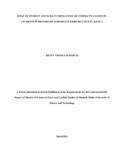| dc.description.abstract | Student conflicts in secondary schools are one of the most common challenges faced in the 21st century in the modern world. Kenya has faced several incidents of student conflicts in Secondary schools mainly attributed to the cases of indiscipline and conflicts among students in the schools. In Kericho County, several incidences of student conflicts have been witnessed in the different schools, which have caused widespread material losses and other social impacts. The study therefore sought to identify ways in which leadership by the students and the students councils can help in managing conflicts that cause students unrest in secondary schools in Kericho County. The overall objective of this study was to examine the role of student councils in mitigation of student conflicts in secondary schools in Kericho County, Kenya. The Specific objectives were to: Examine the nature of Student Unrest in secondary schools in Kericho County, Kenya; Assess the structure and functions of student Councils in secondary schools in Kericho County, Kenya; Evaluate the Successes and Challenges of Student Councils in Mitigation of Student Conflicts in Secondary Schools in Kericho County, Kenya. The study was underpinned by participative leadership theory and the functionalism theory. The study utilized the evaluation research design. The study was conducted in Kericho County. The study targeted the following categories of respondents; students, teachers, school principals or head teachers, School boards of management, County director of education and Sub-county directors of education in Kericho county. Both probability and non-probability sampling techniques were used to obtain respondents. The total sample for the study included 384 students, 120 teachers, 19 school heads or principals, 19 deputy principals, 19 members of the school boards of management, 1 County director of education and 6 sub-county directors of education. The total sample for the study was568 respondents. Data was collected through Questionnaires, Interviews and Focus group discussions. Quantitative data was analyzed using descriptive statistics and presented through frequencies, percentages, mean and standard deviation. Qualitative data analysis utilized data coding and narrative analysis.Data was presented in form of graphs, charts and tables. Only 14% of the respondents agreed that there have been incidences of unrest in their schools within the last 3 years. However, this number is high considering the harm that the unrest causes. Manifestation of student unrest is usually through burning of dormitories, fighting among students, boycotting classes, theft of school property, refusing punishment, bullying and striking against school administration. The causes of students include changes in government policies, poor administrative skills, congestion, inadequate and poor food quality, social media and politicalagitations. On the influencers of student misbehaving, 94% of the teachers and 90% of the students blame friends at schools. The results further 81% of the respondentsindicated that the student council is elected by the students, with the administration having amajor input. Only 16% agreed that there is no interference of the administration in the formation of the SC. Majority (47%) of the student councils has 21-40 prefects, and only afew (10%) have 1-20 students.The results indicate that 68% of the respondents were comfortable with the effectiveness of the SC, 20% indicated that it was too big to be effective, while 12% said it was too small to be effective. Lack of proper training is the major challenge that the student council has in mitigating conflicts. The study recommends that it is important for the government to ensure thorough and enough participation of all stakeholders in the education sector. It also recommends that the government should restrict the interference of the administration in the formation of the student council. The administration in every school should ensure they offer proper training to the student council on conflict mitigation tactics. | en_US |

